
Ancient Journeys: What was Travel Like for the Romans?
It was not uncommon for the ancient Romans to travel long distances all across Europe. Actually during the Roman Empire, Rome had an incredible road network which extended from northern England all the way to southern Egypt. At its peak, the Empire's stone paved road network reached 53,000 miles (85,000 kilometers)! Roman roads were very reliable, they were the most relied on roads in Europe for many centuries after the collapse of the Roman Empire. It could be argued that they were more reliable than our roads today considering how long they could last and how little maintenance they required.
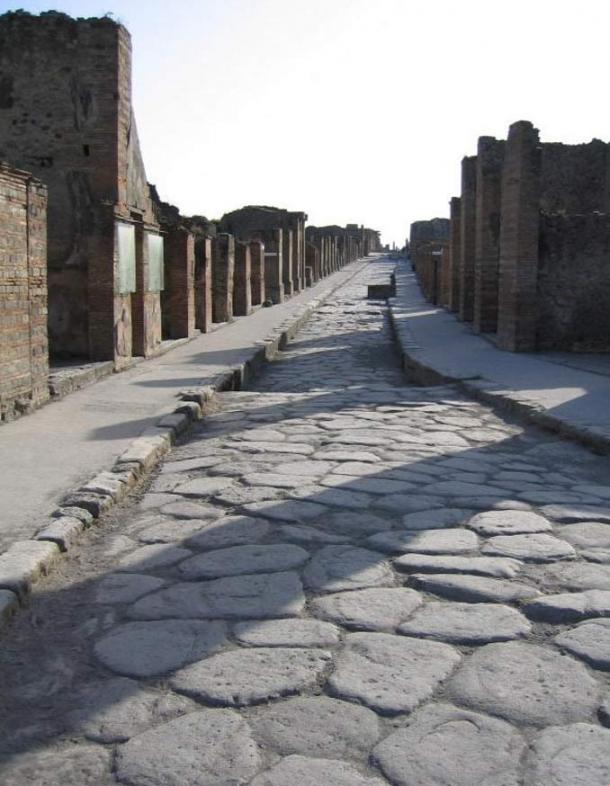
A Roman street in Pompeii. (CC BY-SA 3.0)
Travel by road
Unlike today, travel by road was quite slow and... exhausting! For example, going from Rome to Naples would take over six days in Roman times according to ORBIS, the Google Maps for the ancient world developed by Stanford University. By comparison, it takes about two hours and 20 minutes to drive from Rome to Naples today.
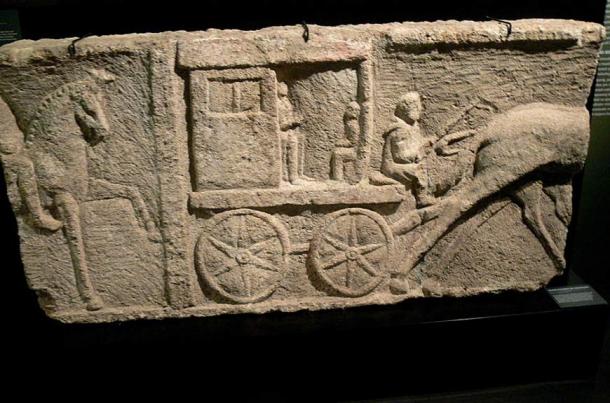
Funeral relief (2nd century ) depicting an Ancient Roman carriage. (CC BY-SA 3.0)
Romans would travel in a raeda, a carriage with four noisy iron-shod wheels, many wooden benches inside for the passengers, a clothed top (or no top at all) and drawn by up to four horses or mules. The raeda was the equivalent of the bus today and Roman law limited the amount of luggage it could carry to 1,000 libra (or approximately 300 kilograms).
- Unraveling the Origins of the Roman Sword Discovered Off Oak Island
- Ancient Roman Tunnel from Gladiator Training School to Colosseum set to be Revived
- 2,200-year-old moat with artifacts linked to Hannibal unearthed in Spain
Rich Romans traveled in the carpentum which was the limousine of wealthy Romans. The carpentum was pulled by many horses, it had four wheels, a wooden arched rooftop, comfortable cushy seats, and even some form a suspension to make the ride more comfortable. Romans also had what would be the equivalent of our trucks today: the plaustrum. The plaustrum could carry heavy loads, it had a wooden board with four thick wheels and was drawn by two oxen. It was very slow and could travel only about 10-15 miles (approximately 15 to 25 kilometers) per day.
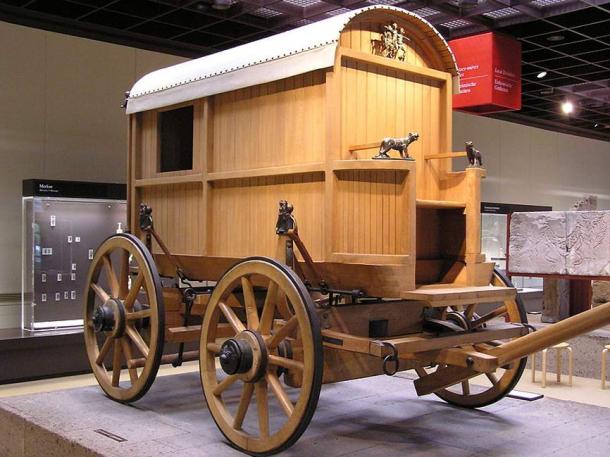
Carpentum replica at the Cologne Museum. (CC BY-SA 3.0)
The fastest way to travel from Rome to Naples was by horse relay or the cursus publicus, which was like a state-run postal service and a service used to transport officials (such as magistrates or people from the military). A certificate issued by the emperor was required in order for the service to be used. A series of stations with fresh and rapid horses were built at short regular intervals (approximately eight miles or 12 kilometers) along the major road systems. Estimates of how fast one could travel using the cursus publicus vary. A study by A.M. Ramsey in "The speed of the Roman Imperial Post" (Journal of Roman Studies) estimates that a typical trip was made at a rate of 41 to 64 miles per day (66 - 103 kilometers per day). Therefore, the trip from Rome to Naples would take approximately two days using this service.
Because of their iron-shod wheels, Roman carriages made of a lot of noise. That's why they were forbidden from big Roman cities and their vicinity during the day. They were also quite uncomfortable due to their lack of suspension, making the ride from Rome to Naples quite bumpy. Fortunately, Roman roads had way stations called mansiones (meaning "staying places" in Latin) where ancient Romans could rest. Mansiones were the equivalent of our highway rest areas today. They sometimes had restaurants and pensions where Romans could drink, eat and sleep. They were built by the government at regular intervals usually 15 to 20 miles apart (around 25 to 30 kilometers). These mansiones were often badly frequented, with prostitutes and thieves roaming around. Major Roman roads also had tolls just like our modern highways. These tolls were often situated at bridges (just like today) or at city gates.
Travel by sea and river
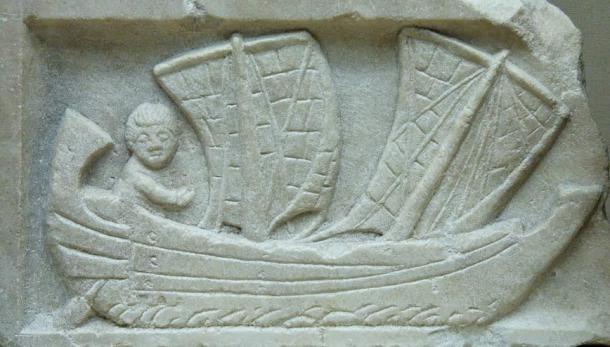
Man sailing a corbita, a small coastal vessel with two masts. (Public Domain)
There were no passenger ships or cruise ships in ancient Rome. But there were tourists. It was actually not uncommon for well-to-do Romans to travel just for the sake of traveling and visiting new places and friends. Romans had to board a merchant ship. They first had to find a ship, then get the captain's approval and negotiate a price with him. There were a large number of merchant ships traveling regular routes in the Mediterranean. Finding a ship traveling to a specific destination, for example in Greece or Egypt, at a specific time and date wasn't that difficult.
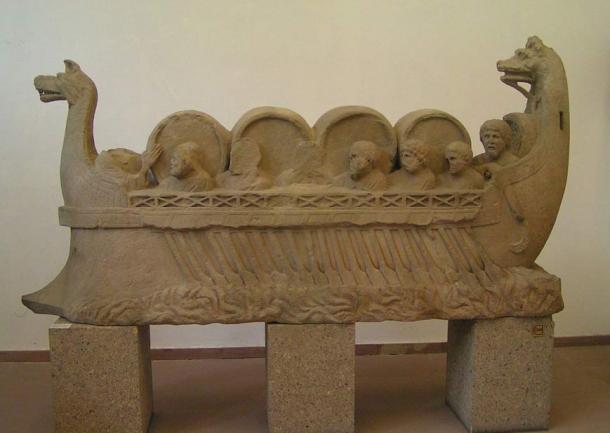
Ancient Roman river vessel carrying barrels, assumed to be wine, and people. (CC BY-SA 3.0)
Romans would stay on the deck of the ship and sometimes there would be hundreds of people on the deck. They would bring their own supplies aboard including food, games, blankets, mattresses, or even tents to sleep in. Some merchant ships had cabins at the stern that could accommodate only the wealthiest Romans. It is worth noting that very wealthy Romans could own their own ships, just like very wealthy people own big yachts today. Interestingly, a Roman law forbade senators from owning ships able to carry more than 300 amphorae jars as these ships could also be used to trade goods.
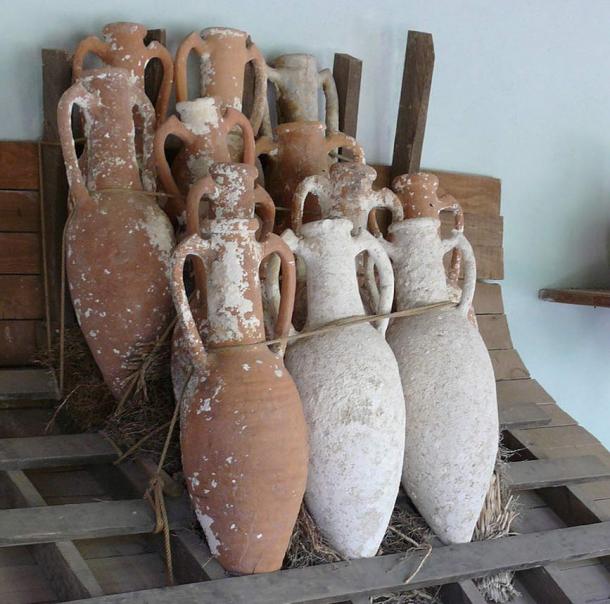
How clay amphorae vessels may have been stacked on a galley. (CC BY-SA 3.0)
- Divers locate 2,000-year-old Roman wreck with cargo of fermented, salted fish intestines
- Rats, Exploding Toilet Seats and Demons of the Deep: The Hazards of Roman Sewers
- Exotic Goods and Foreign Luxuries: The Ancient Roman Marketplace
Traveling by ship wasn't very slow, even compared to modern day standards. For example, going from Brindisium in Italy to Patrae in Greece would take over three days, versus about one day today. Romans could also travel from Italy to Egypt in just a few days. Commercial navigation was suspended during the four winter months in the Mediterranean. This was called the mare clausum. The sea was too rough and too dangerous for commercial ships to sail. Therefore, traveling by sea was close to impossible during the winter and Romans could only travel by road. There were also many navigable rivers that were used to transport merchandise and passengers, even during the winter months.
Traveling during the time of the ancient Romans was definitely not as comfortable as today. However, it was quite easy to travel thanks to Rome's developed road network with its system of way stations and regular ship lines in the Mediterranean. And Romans did travel quite a lot!
Featured image: An ancient Roman road at Leptis Magna, Libya.(CC BY-SA 3.0)
By: Victor Labate
References
Romae Vitam. Roman roads. [Online] Available here.
Watler Scheidel, Elijah Meeks. ORBIS The Stanford Geospatial Network Model of the Roman World. Orbis.Stanford.edu [Online] Available at: http://orbis.stanford.edu
Romae Vitam. Roman carriages. [Online] Available here.
Romae Vitam. Roman ships. [Online] Available here.
















Comments
Somebody should get the radio-metric signatures from the bed rocks. MUCH, MUCH OLDER, (CERTAINLY pre-Roman) than they say. Of course, nothing seems to bring down that big, tall institutional house-of-cards (their stories), tilting now like never before.
Nobody gets paid to tell the truth.
Would love to be there after new york niagara falls to have fun and see more around me.
I read that the postal service could get a message from Canterbury (UK )to Rome (Italy) in 4 days flat, almost as good as airmail today. Incredible.
So the two day rush shipment from Rome to Naples was roughly the same as UPS today!
Fascinating reading about day to day things like this. Would have to be able to have a camera that can look back in time and show what these roads were like. Wonder how busy they got?
Pages